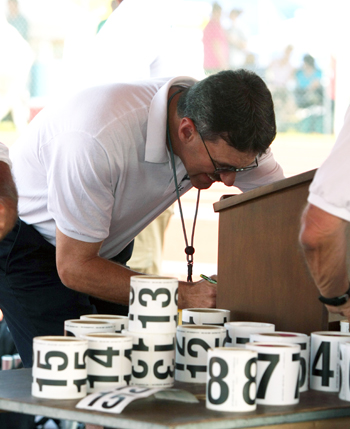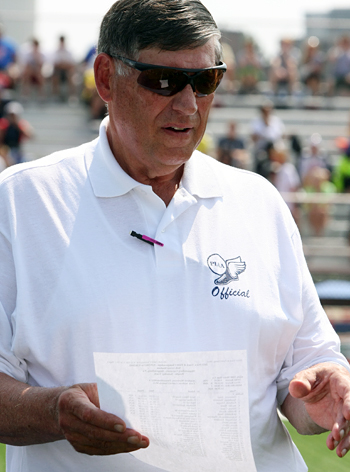
By Phil Grove...
Come the last weekend in May, Jim Frey knows it’s time to bring his “A” game. Hundreds of the state’s best athletes count on Frye and the other PIAA officials overseeing track and field’s annual gathering to make the event come off without a hitch.
 “At the beginning of May, I’ll start telling kids we’re about to enter the championship season and now they need to up their game,” Frye, of Elizabethtown, said of his interaction with athletes throughout the season. “And as an official, you need to up your game and make sure you have everything right, crossing the T’s and dotting the I’s.”
“At the beginning of May, I’ll start telling kids we’re about to enter the championship season and now they need to up their game,” Frye, of Elizabethtown, said of his interaction with athletes throughout the season. “And as an official, you need to up your game and make sure you have everything right, crossing the T’s and dotting the I’s.”
The recently completed 2012 championship meet in Shippensburg surely will rank as one of the best ever, with numerous state records established and even a new national record thrown in for good measure. One constant at each of the yearly meets, according to Dr. Robert Lombardi, PIAA’s associate executive director (and soon to be Executive Director), is experienced and dedicated officials.
“That’s the beauty of our event,” he said. “In the last five to seven years, we have started blending some younger people that have great track acumen in with our experienced people.
“Our experienced folks provide such tremendous leadership because they have something in track that we don’t see always in our sports officiating – they have patience. That’s a big deal. They understand the plight of the athlete more than you do in a football game or basketball game or baseball.”
Schedule Serves as Backbone of Event
Lombardi said the right mix of veteran officials, some with 30 years or more with the PIAA, and the new generation of judges, clerks and umpires can only go so far. Countless hours of preparation are a crucial component of a seamless endeavor such as the state track meet, which featured two full days of activity inside and outside Seth Grove Stadium.
“We take a tremendous amount of time to preplan and organize and tweak our time schedule,” said Lombardi, who will succeed Brad Cashman as PIAA executive director in July. “Once we turn the switch and we start at 9 o’clock, it’s free flowing. If we can keep things timely, no delays, keep people not in a hustling mood but a continuous flow of activity, the event runs smoothly barring the crazy unforeseen.”
According to Lombardi, the most important target that officials have each year is sticking to a schedule that includes a starting time for each of the 72 events.
“If we tell you 9 o’clock, it’s 9 o’clock,” Lombardi said. “It’s not 9:02, it’s not 8:58. It has to be 9 o’clock because that’s our bond.
“Your word is your bond. And that time schedule is our bond. We don’t want to miss anybody. You know what’s happened in the Olympics and all. We don’t want that to happen here.”
 And the job of keeping the meet on schedule this year fell on the 90 PIAA officials on duty for the championship meet. Officials from 10 of the state’s 12 districts were available to work the event.
And the job of keeping the meet on schedule this year fell on the 90 PIAA officials on duty for the championship meet. Officials from 10 of the state’s 12 districts were available to work the event.
“The process to get here is so honed, basically the kids understand what they are doing,” meet referee Jack Hedlund said. “When they get here, you have very few problems.”
A track official since 1979, Hedlund has served as the lead meet official for the past three years after a lengthy tenure as the head field judge. During this year’s gathering, Hedlund was consulted several times Saturday on height progression issues as the Class AAA pole vault competitions went up and up after beginning his day by further clarifying a uniform decision from the previous day.
Hedlund downplayed his role at Shippensburg, noting that there is a system of communicating national rule changes and PIAA modifications annually through rules interpreters to the 1,100 to 1,200 officials and then the state’s coaches works.
“You see 100 officials around here, all of whom could do what I’m doing because they’re plugged into the system and they understand what’s going on,” said Hedlund, who is the sport’s rules interpreter to the National Federation of State High School Associations. “We’ll debate a rule here or there, but for the most part, we’re all on the same page.”
Procedures, Information Point Athletes in Right Direction
Charged with getting the track athletes ready for competition, Frey distributes critical information at the same time that he and two assistants pass out hip numbers and lane assignments at the scoreboard end of the stadium.
“A little bit of organization and then we go over some ground rules, everything that an athlete needs to know in order to perform at their best,” the meet’s clerk of the course said of the procedure followed as the clock winds down on the start time for an event.
Not unlike any competitor or coach, Frye said he critiques his performance at the end of each and every meet: “Is there something I could have said better? Is there a certain way to do things?”
“I always try to learn from other people, and they have their certain styles,” said the 22-year state meet official, who also worked as a finish judge and starting line inspector before moving to the clerking tent two years ago. “I’ve picked up on things throughout the years, so it’s all good.”
Safety, Consistency are Job #1
 As a field event judge at Shippensburg, Christena Harder said her primary goals are obvious – safety and consistency.
As a field event judge at Shippensburg, Christena Harder said her primary goals are obvious – safety and consistency.
“I don’t want anyone to get hurt, whether it’s an official or a contestant,” said Harder, who was in charge of this year’s discus events. “(My goal) is also to keep the playing field really fair, always be consistent. If I’m consistent and all the crew and we’re like minded and we work together as a unit, things will go smoothly. And the boys or girls will be very confident that we’re going to do the best for them and they’re going to have their best performances possible.”
Harder, who has been an official for 33 years, emphasized the importance of rule enforcement throughout the year, eliminating at least one thing that young competitors would have to worry about when competing for state gold.
“Whether it’s a dual meet at the high school or a tri-meet and I have 24 boys competing and I’m running three throwing events, they get the same kind of treatment as they do here at the state meet,” said Harder, who was pulled into officiating by a girlfriend who was a swimming and diving official. “They know what the uniform rule is, they know what the jewelry rule is. After the first or second meet, there’s never any problem because they know I enforce all rules. And they don’t go to an invitational later in the season and not know what the rules are or the expectations.”
Photos by Patty Morgan and Marleen Van den Neste